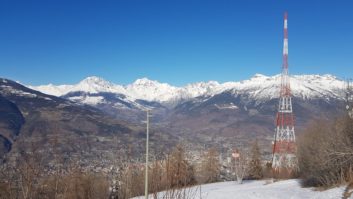AM revitalization is an important industry topic, and in this article we�re going to look at the various techniques used to either expand an existing AM system, or to otherwise leverage its presence.
TAKING ADVANTAGE OF A TOWER�S PRESENCE
The Kintronic Labs ISO-RU-Cat5 provides a means by which Category 5 cables can be run up the tower while isolated from the AM RF.

When many AM transmitter sites were built, 50, 60 or more years ago, they were �way out of town� in locations that seemed, at the time, would never be encroached upon by housing tracts or strip malls. However, as time has gone on, that is exactly what happened with many sites. Now, ironically, many AM antennas are located in areas where it is difficult, if not impossible, to erect other new tower structures. Additionally, the presence of a developed site can be cost-effective for carriers and others seeking co-location. Using an AM site for additional communication services can be a very attractive option for the broadcaster, because of the benefit of this newfound revenue stream and if engineered properly, additions to the system will result in minimal headaches or problems for the existing AM operation.
The entire process can have its complications though. From an article Jeremy Ruck contributed to Radio magazine (http://tinyurl.com/y86drtk8), we have the following caveats:
�…It is also important to remember that the addition of items to elements in a directional array bring in their own set of complexities. The addition of antennas and line will require a partial proof or remodeling, if applicable. These additions will also affect the self- impedance of the tower, which will be different from the drive point impedance. Thus, any adjustments or apparatus used needs to take into account these differences, as well as differences that may occur between different patterns in the same array. Of course, before anything is added to an AM tower, a structural analysis should be performed. In many cases, AM towers were engineered to be essentially naked. As a result, many times there is no opportunity under current standards to add things to a tower and still comply with loading limits.�
Talk to your AM consulting engineer prior to making any changes.
LOCATION OF VHF/UHF SERVICES ON AN AM TOWER
There are plenty of reasons to consider the addition of a VHF or UHF antenna to an AM tower, such as the construction of an auxiliary transmitter site for an FM operation or the addition of an FM translator antenna. It�s not uncommon for stations to locate RPU antennas on top of AM towers, and quite often stations locate 950 MHz STL antennas on AM towers.
One way to accomplish this is an isocoupler, which, as the name suggests, allows you to couple energy (in this case VHF or UHF) while maintaining isolation from the native AM system.
3×3 LBA �CoLoCoil� installation, as seen from the �hot� side of an AM radiator.

LBA Technology�s CAMI series of low, medium and high power broadband isolators allow for the addition of antennas on AM towers. CAMI systems are specifically designed to isolate single coaxial cable feeds for two-way, microwave and STL links, FM translators, FM, LPTV and television translators. Unlike tuned isocouplers, the same broadband CAMI model will fit all of these application frequencies without retuning.
The CAMI isocoupler family supports any combination of RF carriers from DC to 2700 MHz or more, and power levels up to 40,000 watts at FM. High Impedance AM isolation is achieved on any specified frequency between 530�1710 kHz.�Custom AM multi-frequency and high power systems are also available for special applications.
The CAMI provides a simple, cost-effective way to build an AM station�s FM translator because the translator antenna can be mounted on the existing AM tower. CAMIs also pass AC or DC current to tower-top amplifiers and are resistant to weather and lightning.
Kintronic Labs offers the FMC line of isocouplers to facilitate the addition of FM antennas to AM towers. Power levels are from 1.5 kW to 30 kW of VHF power.
Basic specifications for Kintronic Labs� iso-coupler series for FM.

In addition to the FMC family, Kintronic also makes the LPTV isocoupler. (Many LPTV stations are being displaced in the TV repack process, so keep an eye out for potential new clients.) The LPTV isocoupler can handle up to 500 W; however, the ISO-74-LPTV Isocoil series from Kintronic has three separate devices: One to handle up to 6 kW, one for 3 kW and one for up to 1.75 kW.
Kintronic Labs offers their line of PCS isocouplers, for power levels from 100 W to 30 kW at frequencies between 150 MHz and 2.4 GHz, making them suitable for FM, VHF, UHF, cellular, high power paging, STL (studio-transmitter link), wireless internet and PCS applications.
Kintronic Labs also has a line of STL isocouplers. The FMC 0.1, the FMC0.2, and the STL band isocouplers at the 100, 200, and 300 W levels. They are used to facilitate the installation of STL receive or transmit antennas on series-fed towers.
Specifications for the ERI model 404 isolation transformers.Specifications for the ERI 425 series isolation transformers for higher power applications.


ERI offers two different solutions for the use of FM or LPTV on AM towers: The Isolation Transformer models 404 and 425 series. The 404 is for low to medium power applications. (See chart.)
The 425 series is for higher power applications (referring to both the AM power and VHF power). (See chart.)
If your station is bound and determined to use its AM radiator as a means of holding up other antennas, you may want to consider changing it to a folded unipole.
In this case, instead of series feeding the tower, and having it sit above ground on an insulator (with high voltage between the tower and ground), the tower base is grounded and conductors are added, on brackets, so that they envelope the tower. These conductors then make up the radiator.
(Keep in mind that it�s beyond the scope of this article to discuss the pros and cons of converting to a shunt feed from a series feed. We simply present it in the context of the subject. Speak to your AM consultant before opting to go this route.)
Basic drawing of a folded unipole (from Nott Ltd).

The Nott Ltd. folded unipole kit provides several other advantages, in addition to making your AM radiator a more friendly location for other RF services. According to Nott, it can potentially have greater bandwidth, improving the quality of the transmitted audio; and because the tower is now at ground potential, the need for transformers, base insulators, static drain chokes and arc gaps is eliminated. Lightning and static electricity problems are mitigated.
LBA offers the Tunipole, their version of the folded unipole system. Adding to the potential benefits of this type of antenna, LBA writes that it �provides extra bandwidth and efficiency; improves impedance match to reduce tuning unit loss and complexity; has identical radiation pattern to series fed; and, reduces tower height and ground system requirements.� This type of antenna can be used in both directional and non-directional systems.
COMBINING MULTIPLE AM STATIONS INTO A SINGLE ANTENNA ARRAY
While some AM stations are able to take advantage of their tower site location for purposes other than originally intended, some are not, and have chosen to sell out the land that was, for years, an integral part of the antenna array. In some cases, the stations simply go dark; in other cases, engineering studies reveal the technical possibilities in diplexing, or even triplexing, with another local AM array. Several firms are in the business of providing the gear necessary to facilitate such antenna arrays.
Omni-directional multiplexed antenna systems typically consist of a separate matching network and series trap filter to reject each of the other multiplexed frequencies for each of the multiplexed transmitters. These networks are located at the base of the tower with each multiplexer input port fed by a separate transmission line from each corresponding transmitter. Directional multiplexed systems consist of the common point, phasing and power dividing networks (commonly known in toto as the phasor), the antenna tuning units, and the pattern and/or transmitter selection controller for each station. In a directional array each radiator will have a separate matching network and series trap filter to reject of the other multiplexed frequencies. This is installed between the ATU and the tower RF connection.
Kintronic Labs is a very well-known supplier of all of the necessary matching and passive RF filtering to get multiplexed omni-directional or directional stations on the air. (The company recommends the operating frequencies of multiplexed stations be separated by a minimum of 120 kHz for best audio bandwidth results for each station. Multiplexed stations with frequency separation between 70 kHz and 120 kHz additional filters will be required to achieve the desired isolation between the multiplexed transmitters.)
Kintronic Labs utilizes �RF network synthesis techniques for the purpose of optimizing the input impedance bandwidth of each multiplexed antenna system port for an omni-directional tower or for common point bandwidth and pattern bandwidth optimization in the case of a multiplexed directional antenna system,� according to the firm.
An ATU and filter combination for a diplexed system, manufactured by Kintronic Labs.Nine-tower phasor cabinet manufactured by Phasetek.


LBA Technology also offers custom-engineered diplexers, triplexers and multiplexers. Each system is designed for the specific frequencies, transmitter output powers and antenna base impedances and each is typically fabricated in a single, multi-compartment cabinet. The company also manufactures directional phasing equipment, in the range of 250 W to 250 kW, along with ATUs, rejection filters, and a wide range of radio frequency networks. Directional phasing equipment is normally designed to parameters provided by the broadcaster�s consultant.
Phasetek is another veteran company in the AM antenna business. In addition to their line of components for ATU cabinets and phasors (such as fixed and variable inductors and RF contactors) they also design and custom-build ATUs, phasors, diplexers, multiplexers (including the pass/reject filters) and de-tuning systems as well.
APPLICATIONS OUTSIDE OF BROADCAST
In this day and age, broadcast applications only account for a fraction of the potential antenna types that can be installed on AM towers.
Kintronic Labs offers several different means of adding other services to a series-fed tower, including the ISO-TEL Transmission Line Inductor and the ISO-RU-cat5. The former is literally low-loss coaxial cable wound as a coil, allowing for the installation of other antennas on the tower; the latter, a means by which services that need direct cat5 cables can be added to said tower. The category cables are run on the inside of a copper tubing inductor.
An ATU and filter combination manufactured by Phasetek.


LBA Technology offers the CoLoCoil system, a variation of the iso-coupler idea, using parallel-resonant filters, composed of the outer conductor of the coax, and a parallel capacitor, to reject any RF energy from the tower itself, while allowing for installation of other RF services on a hot tower
According to LBA, the tuned circuits present a �lower capacitive footprint to the tower�s lump base capacitance,� while allowing the RF path for the cellular company, and a DC path for any control systems, or tower-mounted amplifier systems. The company also says they�re ideal for AM directional arrays; will pass DC to 2700 MHz signals; and, they offer low insertion loss and low intermod distortion.
While AM antennas have always been used by the station in their quest for revenue generation, they are themselves now a means by which the station can generate extra revenue. We all know of cases where the land formerly occupied by the antenna became more valuable than the station itself. For stations that remain viable, the latest technology, described herein, can potentially improve the revenue outlook.












